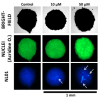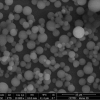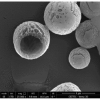Porous Nanoparticles for Targeted Delivery
Technology description
| The name of the technology: | Porous Nanoparticles for Targeted Delivery |
|---|---|
| Challenge: | In general, nanostructural porous systems are desirable materials with a broad scope of industrial applications. Novel systems which would additionally possess low toxicity are even more on demand. Our main motivation in developing such porous nanomaterials derived from sustainable non-toxic natural compounds was inspired by the fact that there is a great number of active pharmaceutical ingredients (APIs) that show promising biological effects in (pre)clinical studies, but their chances for final clinical use are generally low, which ultimately causes high drugs’ cost. APIs but also approved drug failures are usually related to low bioavailability, stability, selectivity, and with that related deleterious side-effects. These drawbacks can be reduced or even eliminated by utilizing side-specific non-toxic drug carriers. Besides medicinal applications, these chiral metal-organic materials can find use in the food industry, agriculture, cosmetics, catalysis, or separations. |
| Description: |
There is a great number of carrier systems studied such as liposomes, polymers, porous silicates, or nanocrystals of metal-organic frameworks (MOFs). Next to MOFs, a novel group of porous metal-organic materials recently emerged - infinite coordination polymers (ICPs). The ICP particles provide tailorability of their composition, size, and shape, and they also have to some extent dynamic character allowing their structural reorganization upon changes to external conditions (solvent, pH, temperature, pressure, etc.). We have designed and prepared many steroid-based ligands. A simple combination of ligands with selected essential or less toxic metal salts under specific conditions led to a great number of various mostly spherical ICP nanoparticles. The particle size ranges from 100 nm to 5 μm with a small size dispersity (with the average size of about 500 nm to 1 μm) in dependence on metal salt and reaction conditions used. They are mostly mesoporous with specific surface areas up to 550 m2/g. Their toxicity level was studied using human hepatocytes and enterocytes showed low toxicity. Using a fluorescent steroidal ligand, we were even able to follow by fluorescent microscopy ligand’s uptake and accumulation in 3D spheroid hepatocyte models. The steroidal particles are stable in an aqueous environment, yet, are expected to be easily biodegradable as assumed from the ligand structure. The biological properties of the building blocks also predestine their ability to penetrate actively and passively through biological membranes. In general, the key advantages of steroid ICPs compared to other porous carrier systems are: - tailorability in terms of composition, size, and shape, thus also their physicochemical properties, - structural reorganization upon changes to external conditions (solvent, pH, temperature, pressure, etc.), - possible control over the gradual release of adsorbed molecules based on slow desorption or carrier decomposition, - low-toxicity, biocompatibility, and targeting, - possibility of surface modifications enabling additional control over their stability, guest release, targeting, etc., - lower production cost and sustainability. |
| Commercial opportunity: |
The steroidal ICPs developed at Masaryk University can find many applications in the pharmaceutical industry which can be drawn but are not limited to bioactive targeting carriers (e.g., as components of dermal pharmacology creams and ointments, or for targeting enterohepatic circulation), anti-inflammatory and antimicrobial agents, antioxidants, as contrast agents for bioimaging, as vaccine adjuvants, etc. Their potential can also be seen as carriers of medical food supplements, e.g., vitamin E, zinc, or those with positive effects on the liver - quercetin, hydroxytyrosol, resveratrol, silibinin, etc. In the food industry, acting as antioxidants, emulsifiers, protecting capsules for nutrients, various types of carriers, or antimicrobial agents. In agriculture as carriers of pesticides and growth hormones. Similarly, they can be used in regeneration and conditioning cosmetics, e.g., as protecting capsules and bioactive carriers of nutrients and vitamins ensuring their stability and slow release, as a smart replacement for microplastics, etc. Having in hand chiral metal-organic porous materials their applications can also be extended to enantioselective catalysis (nanoreactors), adsorptions and separations of chiral compounds, or storage of gases. |
| IP protection status: | Know-how |
| Development status: |
Phase 2Corresponds with TRL 3 and TRL 4 Feasibility study. There is a realistic design of the technology and the initial tests in the laboratory are leading to the specification of the technology requirements and its capabilities.
|
| Partnering strategy: | Co-development Collaboration investment licensing |
| More information: | Figure 1. SEM image of spherical steroidal ICP particles, B) interestingly, gallium beam-cut revealed hollow ICP particles (nevertheless, majority of particles are filled), C) uptake and accumulation of fluorescent NL01 ligand in hepatospheroid observed by fluorescent microscopy. |
| Images: | |
| Categories: | Agriculture Pharma Chemistry Food industry |
| Owner of a technology: | Masarykova univerzita |



